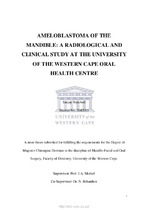Ameloblastoma of the mandible: A radiological and clinical study at the University of the Western Cape Oral Health Centre
| dc.contributor.advisor | Morkel, Jean | |
| dc.contributor.author | Ranchod, Sanjay | |
| dc.date.accessioned | 2020-02-17T09:47:45Z | |
| dc.date.available | 2020-02-17T09:47:45Z | |
| dc.date.issued | 2019 | |
| dc.identifier.uri | http://hdl.handle.net/11394/7110 | |
| dc.description | Magister Chirurgiae Dentium - MChD | en_US |
| dc.description.abstract | Ameloblastoma is the most common benign tumour of odontogenic origin and presents five times more in the mandible than in the maxilla (Reichardt et al. 1995). Although benign, it exhibits an invasive behavioural growth pattern with a high rate of recurrence if not managed appropriately. Ameloblastoma occurs in all age groups, but is most common in patients between the ages of 20 and 40 years. Males and females are equally affected. Clinically, ameloblastoma presents as a slow-growing, painless tumour, which if left untreated, can grow to enormous proportions. Radiographically, the lesion presents as either multilocular or unilocular radiolucency. The internal appearance of multilocular lesions may resemble a soap-bubble, honeycomb or spider-like pattern. Combinations of these patterns are not unusual. | en_US |
| dc.language.iso | en | en_US |
| dc.publisher | University of the Western Cape | en_US |
| dc.subject | Mandible | en_US |
| dc.subject | Ameloblastoma | en_US |
| dc.subject | Pantomograph | en_US |
| dc.subject | Retrospective study | en_US |
| dc.subject | Odontogenic tumour | en_US |
| dc.title | Ameloblastoma of the mandible: A radiological and clinical study at the University of the Western Cape Oral Health Centre | en_US |
| dc.type | Thesis | en_US |
| dc.rights.holder | University of the Western Cape | en_US |

